The question that all learner drivers would like to know is of course ‘Will I pass my driving test?’ So what better than to go through the Will I pass my driving test quiz.
Ok, so it’s not going to tell you if you are going to pass or fail. There’s so many variables for the practical driving test that can determine a pass or fail, but what this quiz will do is to test your knowledge on a few more obscure situations that can easily fail a driving test.
In fact, the quiz is based around many of the common reasons for driving test failures each and every year with many of them being in the DVSA top 10 reasons for failure.
Simply run through the practical driving test quiz, choose your answer and select the ‘Check’ button to see if you have selected the correct answer. Then continue with the next question.
Am I ready for the driving test? let’s go! Hit the start quiz button below to answer 18 questions.
Practical Driving Test Quiz
Quiz-summary
0 of 18 questions completed
Questions:
- 1
- 2
- 3
- 4
- 5
- 6
- 7
- 8
- 9
- 10
- 11
- 12
- 13
- 14
- 15
- 16
- 17
- 18
Information
A quiz that determines if you are ready to take the UK practical driving test.
You have already completed the quiz before. Hence you can not start it again.
Quiz is loading...
You must sign in or sign up to start the quiz.
You have to finish following quiz, to start this quiz:
Results
0 of 18 questions answered correctly
Your time:
Time has elapsed
You have reached 0 of 0 points, (0)
| Average score |
|
| Your score |
|
Categories
- Not categorized 0%
- 1
- 2
- 3
- 4
- 5
- 6
- 7
- 8
- 9
- 10
- 11
- 12
- 13
- 14
- 15
- 16
- 17
- 18
- Answered
- Review
-
Question 1 of 18
1. Question
It’s important that you remember to take one of the items detailed below to your driving test. If you don’t, the driving test will be terminated. Which one is it?
Correct
You can continue with your driving test. Essentially you need only to take your provisional licence, though it may prove beneficial to take along your theory test pass certificate and a print of your driving test booking confirmation in case of any unforeseen issues. You can leave your hamster at home.
Incorrect
Your driving test has been terminated. Your provisional driving licence provides proof of identification. Without this, your test will not continue.
-
Question 2 of 18
2. Question
In terms of driving, what is a blind spot?
Correct
Many road accidents occur due to drivers not checking the blind spot. Always check the appropriate side blind spot before changing lanes or before making a change of direction where your actions may impact on other road users. See blind spot for further information.
Incorrect
The blind spot are areas to the side and rear of your vehicle that cannot be seen in your mirrors. Many road accidents occur due to drivers not checking the blind spot. Always check the appropriate side blind spot before changing lanes or before making a change of direction where your actions may impact on other road users. See blind spot for further information.
-
Question 3 of 18
3. Question
The examiner has asked you to pull over at the side of the road. Before moving off, you should:
Correct
Well done! Many driving tests are failed for not moving off correctly.
Incorrect
You just failed! Safety observational checks must always be the last action taken before moving off. If you forget to prepare the car after safety checks, get the car prepared to move, then run through the safety checks again and you’ll be fine. Moving off and not performing the appropriate safety checks beforehand is in the official DVSA top 10 test failures each and every year. See moving off for further help.
-
Question 4 of 18
4. Question
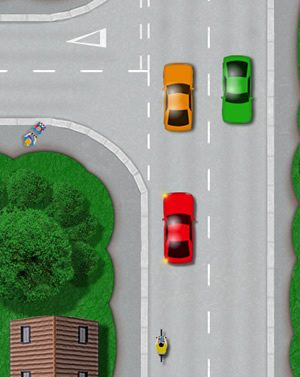
You are making a left turn from a busy major road. From the list below, just before committing to the left turn, you should check:
Correct
Busy urban roads where cyclists are present will require you taking a final look into the left door mirror to ensure no cyclists are riding up alongside you. If they are, slow down or stop to allow them to pass before making the turn. If you are not completely sure it’s safe to turn, check also your left-side blind spot before committing to the turn. Use of mirrors, or rather a lack of use of mirrors is the 2nd reason for all DVSA test failures on almost each year. See left and right turns for further advice.
Incorrect
Whilst there’s no particular harm in checking this, you have to assess the most important procedure at any given time. Busy urban roads where cyclists are present will require you taking a final look into the left door mirror to ensure no cyclists are riding up alongside you. If they are, slow down or stop to allow them to pass before making the turn. If you are not completely sure it’s safe to turn, check also your left-side blind spot before committing to the turn. Use of mirrors, or rather a lack of use of mirrors is the 2nd reason for all DVSA test failures on almost each year. See left and right turns for further advice.
-
Question 5 of 18
5. Question
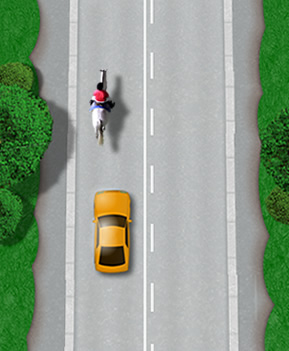
Based on this diagram, what should you do?
Correct
Excellent! You may legally cross the solid white line, overtaking the horse providing it is safe for yourself, the horse and rider and any other road users.
It is illegal to cross a continuous solid white line if the solid line is on your side of the road, except under certain conditions. You are permitted to straddle or cross a continuous solid white line to enter a side road or property, to manoeuvre round a stationary vehicle blocking your side of the road, to overtake cyclists, a horse or a road works vehicle moving at 10 mph (16 km/h) or less. See double white lines for further information.
Incorrect
You may legally cross the solid white line, overtaking the horse providing it is safe for yourself, the horse and rider and any other road users.
It is illegal to cross a continuous solid white line if the solid line is on your side of the road, except under certain conditions. You are permitted to straddle or cross a continuous solid white line to enter a side road or property, to manoeuvre round a stationary vehicle blocking your side of the road, to overtake cyclists, a horse or a road works vehicle moving at 10 mph (16 km/h) or less. See double white lines for further information.
-
Question 6 of 18
6. Question
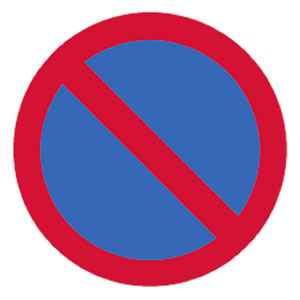
You intend on parking up on the left and see this sign. What does it mean?
Correct
That’s right! No waiting signs mean that you are permitted to momentarily stop to allow passengers to enter or exit the vehicle for example, but then must continue with your journey.
Incorrect
No waiting signs mean that you are permitted to momentarily stop to allow passengers to enter or exit the vehicle for example, but then must continue with your journey. For further information, see no stopping and no waiting signs.
-
Question 7 of 18
7. Question
It’s a perfect clear dry day for your driving test and you are out with your examiner in your instructors brand new Ford. The examiner asks you to pull over on the left and explains that they wish for you to demonstrate the emergency stop. After the examiners signal to stop, you intend on:
Correct
Well done! If you are using a vehicle made after 2004 it will have anti-lock brakes as standard and if the roads are dry, there is no chance of the wheels locking and a loss of control occurring regardless of how hard you hit the brake pedal. For further information see the emergency stop tutorial.
Incorrect
If you are using a vehicle made after 2004 it will have anti-lock brakes as standard and if the roads are dry, there is no chance of the wheels locking and a loss of control occurring regardless of how hard you hit the brake pedal. Progressive braking is a technique that should be applied to normal braking procedures and not the emergency stop. See braking techniques.
You should never waste time checking the mirrors as the examiner will ensure it is safe to stop.
Whilst braking, especially harshly, all weight is shifted forward. Keep both hands on the wheel to ensure you can remain secure in your seat.
The clutch must be depressed just before you stop and not before the brake else braking efficiency is reduced. See engine braking.
For further information see the emergency stop tutorial.
-
Question 8 of 18
8. Question
As a novice driver, it can be difficult to judge a safe distance from the vehicle in front whilst driving. An easy method is to:
Correct
Excellent! The 2 second rule offers an easy method for establishing a safe thinking and braking (stopping) distance from the vehicle in front should you need to stop in an emergency. Remember though, it becomes the 4 second rule when it’s wet and much longer if icy. See 2 second rule for further information.
Incorrect
The 2 second rule offers an easy method for establishing a safe thinking and braking (stopping) distance from the vehicle in front should you need to stop in an emergency. Remember though, it becomes the 4 second rule when it’s wet and much longer if icy. See 2 second rule for further information.
-
Question 9 of 18
9. Question
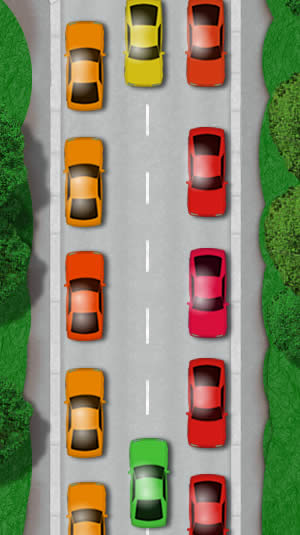
With cars parked along both sides of the road, which car has priority, the green or yellow car?
Correct
That’s correct.
Incorrect
If there are parked cars on your side of the road, you must give way to oncoming vehicles and the opposite applies to oncoming vehicles where they have parked cars on their side of the road. With vehicles parked on both sides of the road, no one has priority. Either vehicle must use the nearest available gap on their side of the road to pull into. See passing parked cars for further information.
-
Question 10 of 18
10. Question
You’re in the red car intending to turn right at this crossroads. Based on the image, would you view your current position as:
Correct
Correct. Never enter the yellow box area of a junction unless your intended exit from the box is clear. Yellow boxes are typically placed within busy junctions where it is an offence to wait inside the box due to your exit not being clear. By doing so, you will prevent traffic flow and increase congestion. It is however acceptable to wait inside the yellow box for passing traffic to clear, but only if your exit is clear. See box junction for further information.
Incorrect
Never enter the yellow box area of a junction unless your intended exit from the box is clear. Yellow boxes are typically placed within busy junctions where it is an offence to wait inside the box due to your exit not being clear. By doing so, you will prevent traffic flow and increase congestion. It is however acceptable to wait inside the yellow box for passing traffic to clear, but only if your exit is clear. See box junction for further information.
-
Question 11 of 18
11. Question

Whilst driving, you see this sign. You must:
Correct
That’s correct! Minimum speed limits are rarely used on UK roads, but where used, they are placed in such locations so to maintain a free flow of traffic to prevent ‘bottlenecks’ and congestion. See minimum speed limit signs for more help.
Incorrect
These signs are applicable to all road vehicles. Minimum speed limits are rarely used on UK roads, but where used, they are placed in such locations so to maintain a free flow of traffic to prevent ‘bottlenecks’ and congestion. See minimum speed limit signs for more help.
-
Question 12 of 18
12. Question
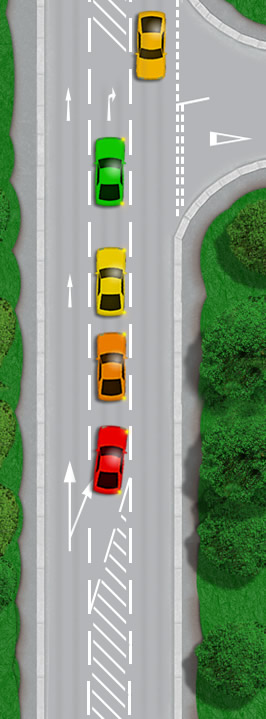
Driving along this road, you intend on turning right. The queue is stationary waiting for traffic to pass. Stopping behind the last car in the queue (red car), where should you position your vehicle?
Correct
Incorrect
Hatched or chevron road markings contained within a continuous solid line must not be entered, whilst those that are contained within a broken dashed line can legally be entered. Hatched road markings are used to separate traffic flows and those contained inside dashed broken lines should be avoided unless it is safer to enter. Based on the situation in the image, it would be safer and convenient for other road users if you stopped behind the red car inside the hatched area. See hatched road marking for more information.
-
Question 13 of 18
13. Question
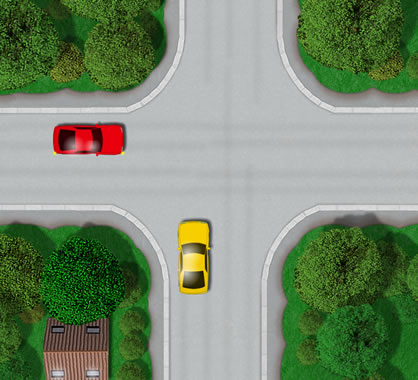
You will often find these types of junctions on very quiet residential streets or along country roads. Who has right of way, the red car turning right or the yellow car following the road ahead?
Correct
Incorrect
This type of junction is a crossroads, or more specifically an unmarked crossroads. This means that it’s not controlled by traffic lights and has no road markings or signs to dictate who has right of way. At an unmarked crossroads, no one has right of way. Always approach slowly and with extreme caution. For a full explanation of the various types of crossroads, see crossroads junctions.
-
Question 14 of 18
14. Question
During the forward drive into a bay manoeuvre, you are about to begin reversing. The very last thing you should do before reversing the car is?
Correct
Incorrect
You should always physically look in the direction you intend on moving, before moving the vehicle. This applies to all manoeuvres and general driving. You can see more by physically looking rather than relying on mirrors alone. Also, you will fail the driving test if you do not do this! See driving test manoeuvres for further information.
-
Question 15 of 18
15. Question
You are approaching a large roundabout with multiple lanes. You realise that you’re in the incorrect lane for your intended destination. You should:
Correct
Incorrect
Well, you can stay in the incorrect lane if you wish, but it’s a bit daft if you don’t make some form of attempt to rectify the situation. Before attempting to change lanes, you must always check your mirrors initially, followed by the blind spot and then signal your intention if all is clear. Always check the applicable side blind spot before changing any lane. If you feel that changing lanes is to hazardous, stay where you are and the examiner will provide an alternative route.
-
Question 16 of 18
16. Question
The examiner has asked you to demonstrate the reverse parking manoeuvre. During the manoeuvre you have lost your bearings and are unable to see where the kerb is in relation to your position. What are you going to do?
Correct
Incorrect
Each and every year, the reverse park manoeuvre and a lack of control is in the official DVSA top 10 reasons for test failures (hitting the kerb). All manoeuvres, not just the reverse park are based on real-life driving situations and as such, you often have to readjust the position of the vehicle for accuracy. If you find that you have lost sight of where you are in relation to the kerb, then firstly, you’re doing it too fast. Slow it down and if necessary, stop the vehicle when looking around (this means you’ll not lose any ground when performing observations). Safely (observational checks first) move forward to a position that once again allows you to see the kerb and start again from that position. Remember though, slow it down. See driving test manoeuvres for further information.
-
Question 17 of 18
17. Question
Response to signals (traffic lights) is consistently within the official DVSA top 10 reasons for test failures. Why?
Correct
Anticipation and planning is the most important aspect of driving throughout your lifetime. Anticipate a situation, for example you see up ahead that traffic lights have been on green for some time, you anticipate them changing as you approach. Planning ahead you decide to check your mirrors and ease off the speed as you approach the lights in preparation to stop (if necessary). You can anticipate many situations and plan accordingly. For example, on approaching roundabouts, look for other roads entering the roundabout and the vehicles on these roads will help you anticipate whether you’ll need to stop or continue. Or down the road there’s a pedestrian crossing with people who are waiting. You will anticipate the lights changing before you pass and can plan for this.
Incorrect
Anticipation and planning is the most important aspect of driving throughout your lifetime. Anticipate a situation, for example you see up ahead that traffic lights have been on green for some time, you anticipate them changing as you approach. Planning ahead you decide to check your mirrors and ease off the speed as you approach the lights in preparation to stop (if necessary). You can anticipate many situations and plan accordingly. For example, on approaching roundabouts, look for other roads entering the roundabout and the vehicles on these roads will help you anticipate whether you’ll need to stop or continue. Or down the road there’s a pedestrian crossing with people who are waiting. You will anticipate the lights changing before you pass and can plan for this.
-
Question 18 of 18
18. Question
Finally, can you guess which is the official DVSA number 1 reason for test failures each and every year?
Correct
Yep, junctions and a lack of appropriate observation is the number 1 reason for test failures each and every year. The reason is of course a lack of anticipation and planning. Junctions vary considerably based on type of junctions, size and how busy they are. In good time, you need to locate the junction. Look for road signs, looking ahead, check for road markings, cars crossing you path ahead or anything else that signifies a junction is ahead. You will of course need to run through the MSPSL routine but equally importantly, anticipate whether the junction is closed (you can’t see much of the road you intend on joining) or open (you can clearly see the road you intend on joining). Based on this, you plan an appropriate speed and whether you need to stop or continue without stopping if clear.
Before you have crossed the junction line, you will of at least needed to have looked right, left and right again and given yourself time to react to the situation. If this all seems too rushed, then you’re traveling too fast. See types of junctions for further advice.
Incorrect
Junctions and a lack of appropriate observation is the number 1 reason for test failures each and every year. The reason is of course a lack of anticipation and planning. Junctions vary considerably based on type of junctions, size and how busy they are. In good time, you need to locate the junction. Look for road signs, looking ahead, check for road markings, cars crossing you path ahead or anything else that signifies a junction is ahead. You will of course need to run through the MSPSL routine but equally importantly, anticipate whether the junction is closed (you can’t see much of the road you intend on joining) or open (you can clearly see the road you intend on joining). Based on this, you plan an appropriate speed and whether you need to stop or continue without stopping if clear.
Before you have crossed the junction line, you will of at least needed to have looked right, left and right again and given yourself time to react to the situation. If this all seems too rushed, then you’re traveling too fast. See types of junctions for further advice.
Top 10 Driving Test Failures
Once you have completed the driving test quiz, check out the UK top 10 driving test failures from the year 2006 to 2017, based on all practical test centres combined. Data comprised on a yearly basis.

The statistics might surprise you. Nothing much has changed over the years. If you have yet to take your practical driving test, hopefully you’ll become one of the driving test pass rate statistics.
Quizzes to Help You Pass the Driving Test
At the Start of the driving test, you’ll need to answer the Show Me Tell Me questions which are full detailed on the Show Me Tell Me page along with all the answers. There’s also a quiz to test your knowledge on these questions.

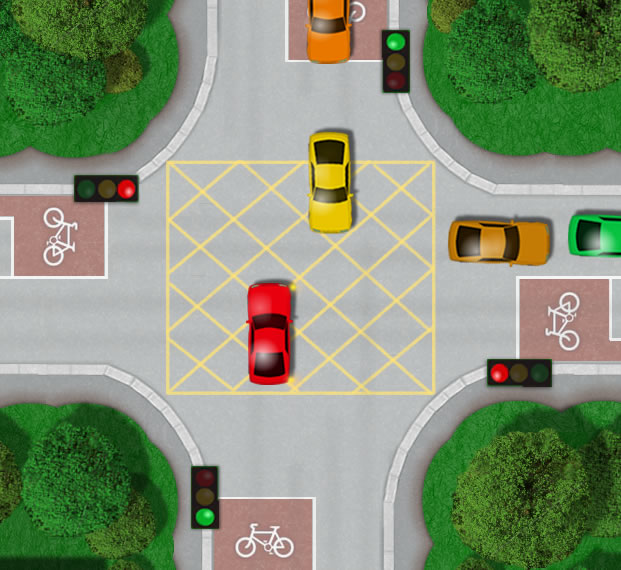
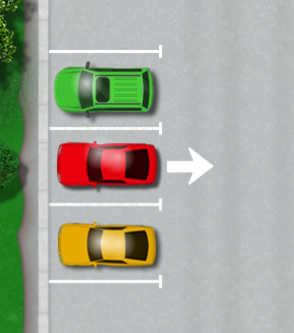
Thank you this has help me I will pass my test
13/18
72.22%
higher than average
63.31%
My test is on Wednesday so I’m brushing up on some things.
Good luck Miles 🙂
Thank you
I’m feeling quite confident now, I’ve done some driving with my dad yesterday and today which was definitely really helpful.
Rey i pass my driving test years back, i just check if i still a good driver i score 83.33 so higher than average
Well Done Rey 🙂
100%, already passed my test just did it for fun 😂
Congratulations, Bob!
A car of mass 2000kg starts from rest as some traffic lights. After travelling 400m the car’s speed is 12m/s. A constant resistance of 500N acts on the car. Calculate the driving force, which can be assumed to be constant.